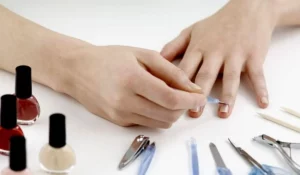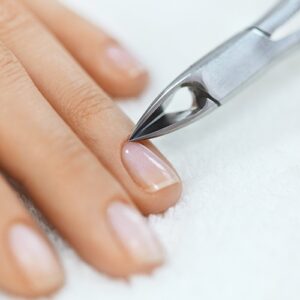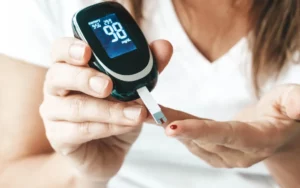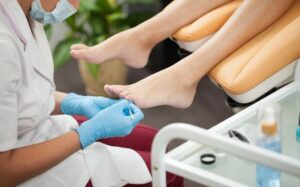Living with diabetes requires attentive care and management of your overall health, including the health of your nails. Diabetics are often more susceptible to nail infections and other complications due to changes in blood circulation and the immune system. Therefore, proper nail care is not just a matter of aesthetics, but also an essential aspect of maintaining good health. In this blog, we’ll explore why nail care is particularly important for diabetics and provide practical tips for nail care for diabetics and techniques to ensure your nails remain healthy and well-cared for.
Contents
Why Do Diabetics Need Nail Care?
 Diabetics need to pay special attention to nail care for several reasons related to the effects of diabetes on the body:
Diabetics need to pay special attention to nail care for several reasons related to the effects of diabetes on the body:
- Reduced Blood Circulation: Diabetes can lead to poor blood circulation, particularly in the extremities like feet and hands. Poor circulation can weaken the nails, making them more susceptible to infections and slower to heal if injured or infected.
- Increased Risk of Infection: High blood sugar levels can impair the body’s ability to fight off infections. This means that any cuts, cracks, or injuries around the nails can become entry points for bacteria or fungi, leading to infections more easily than in non-diabetics.
- Nerve Damage (Neuropathy): Diabetes can cause neuropathy, which is damage to the nerves, especially in the feet and hands. This can lead to a reduced sensation, meaning that injuries or abnormalities in nail health might not be noticed immediately, delaying treatment.
- Fungal Infections: Diabetics are more prone to fungal infections like onychomycosis. This affects the nails. Such infections can lead to thickening, discoloration, and brittleness of nails.
- Changes in Nail Appearance: Diabetes can cause changes in the appearance of nails, such as yellowing, thickening, or developing ridges. This might indicate underlying health issues.
- Skin Complications: Diabetes can affect the skin, making it drier and more prone to cracking. This can extend to the cuticles and skin around the nails, increasing the risk of infections.
Given these factors, diabetics must maintain good nail care as a preventive measure to avoid complications. This includes regular inspection of nails, keeping nails clean and trimmed, moisturizing the skin around the nails, and seeking medical attention for any signs of infection or unusual changes in nail condition.
What Are The Tips For Nail Care For Diabetics?
Nail care for diabetics is particularly important due to their increased risk of infections and complications. Here are some essential tips for diabetic nail care:
Inspect Nails Regularly
Regular inspection of your nails is crucial for diabetics. You should look for changes in color, texture, or shape that might indicate a health issue. Common concerns include yellowing of the nails, thickening, brittleness, or the development of ridges. Diabetics should also be vigilant for signs of fungal infections or ingrown nails. If you notice any abnormalities, it’s important to consult a healthcare provider promptly. For those with neuropathy and reduced sensation in their extremities, a visual inspection is essential, as you may not feel pain or discomfort from an emerging issue.
Keep Nails Clean and Dry
Cleanliness is key in preventing nail infections. You should wash your hands and feet daily, paying particular attention to the nails and the spaces between them. Use a gentle soap and avoid harsh chemicals that can exacerbate dryness. After washing, it’s critical to dry your feet and hands thoroughly, especially the areas between your toes and around your nails, as moisture can create an ideal environment for fungal growth.
Trim Nails Carefully
Proper trimming of your nails can prevent many common issues such as ingrown toenails and infections. Trim your nails straight across, rather than curving the edges, to reduce the risk of ingrown nails. It’s also important to avoid cutting them too short, which can expose the sensitive skin underneath and lead to infections. After trimming, use a nail file to smooth any sharp or jagged edges. This can catch on socks or stockings and cause tears in the skin.
Avoid Cutting Cuticles
 The cuticles serve as a protective barrier against infections. Pushing back the cuticles gently is safer than cutting them. Cutting cuticles can create small cuts which act as entry points for bacteria and fungi. If you’re getting a professional manicure or pedicure, ensure that the technician understands your condition and takes appropriate care of your cuticles.
The cuticles serve as a protective barrier against infections. Pushing back the cuticles gently is safer than cutting them. Cutting cuticles can create small cuts which act as entry points for bacteria and fungi. If you’re getting a professional manicure or pedicure, ensure that the technician understands your condition and takes appropriate care of your cuticles.
Use Proper Tools
Using clean and sanitized nail care tools is essential to prevent infections. Tools should be sterilized between uses, and diabetics should have a personal set of nail care tools to reduce the risk of cross-contamination. This is especially important for items like nail clippers, files, and cuticle pushers.
Moisturize Your Nails and Cuticles
Diabetes can cause dry and cracked skin, which extends to the cuticles and nails. Regularly applying a moisturizer can help prevent this. Look for products specifically designed for diabetics or those for sensitive skin. However, be cautious with moisturizing between your toes, as excessive moisture in these areas can promote fungal growth.
Wear Proper Footwear
Footwear plays a significant role in diabetic foot care. Shoes should fit well and provide adequate support and protection to reduce the risk of injuries to the nails and feet. Shoes that are too tight can cause pressure on the nails, leading to pain and ingrown toenails, while shoes that are too loose can lead to friction and injuries. It’s also beneficial to wear socks that wick moisture away from the skin to keep your feet dry.
Avoid Walking Barefoot
For diabetics, walking barefoot increases the risk of foot injuries, which can lead to serious infections due to the reduced ability to heal and fight infection. Even minor cuts or abrasions from walking barefoot can become problematic. Always wear shoes, even indoors, to protect your feet from accidental injuries. This is especially important in areas where you might step on something sharp or rough.
Monitor Blood Sugar Levels
 Effective management of blood sugar levels is a cornerstone of diabetic care and has a direct impact on nail health. High blood sugar can impair the body’s ability to fight infections and slow down healing processes, increasing the risk of nail and foot-related complications. By keeping blood sugar levels within the recommended range, you reduce the risk of these complications.
Effective management of blood sugar levels is a cornerstone of diabetic care and has a direct impact on nail health. High blood sugar can impair the body’s ability to fight infections and slow down healing processes, increasing the risk of nail and foot-related complications. By keeping blood sugar levels within the recommended range, you reduce the risk of these complications.
Be Cautious with Nail Salons
If you choose to visit a nail salon, it’s essential to ensure that it adheres to strict hygiene practices. Tools should be sterilized, and foot baths should be cleaned between clients to prevent the spread of infections. Inform the technician about your diabetes. So they can take appropriate precautions. Consider bringing your own set of sanitized tools for added safety.
Stay Hydrated and Maintain a Balanced Diet
Good nutrition and hydration are important for overall health and can positively impact nail health. A balanced diet rich in vitamins and minerals supports nail strength and growth. Staying hydrated helps maintain the moisture balance in your skin and nails, preventing dryness and brittleness.
Stop Smoking
Smoking has a detrimental effect on circulation, which is already a concern for diabetics. Poor circulation can further impair the health of your nails and feet, increasing the risk of infections and delaying healing. Quitting smoking can improve circulation and overall health, thereby reducing these risks.
Be Alert to Warning Signs
Prompt attention to any signs of infection or other nail problems is crucial. Warning signs include redness, swelling, pain, or the discharge of pus around the nails. If you experience any of these symptoms, consult a healthcare professional immediately. Early treatment can prevent more serious complications.
By following these guidelines, diabetics can better manage their nail health, reducing the risk of complications that can arise from diabetes-related conditions. Regularly consulting with healthcare professionals and maintaining an overall healthy lifestyle are key components of effective diabetic foot and nail care.
Who Takes Care Of The Nails Of Diabetic Patients?
 The care of nails in diabetic patients often involves a team approach, including several healthcare professionals:
The care of nails in diabetic patients often involves a team approach, including several healthcare professionals:
- Primary Care Physician or Endocrinologist
The primary care physician or endocrinologist who manages the overall diabetic condition plays a key role. They can provide general guidance on foot and nail care and are often the first to advise a patient when specialized care is needed.
- Podiatrist (Foot Specialist)
A podiatrist specializes in foot care and is an essential part of the team caring for a diabetic patient’s feet and nails. They are skilled in treating common diabetic foot problems, including nail infections, ingrown toenails, and other conditions related to poor circulation or neuropathy.
- Certified Diabetes Educator
A certified diabetes educator can provide valuable education and resources regarding overall diabetes management, including foot and nail care. They help patients understand why foot care is critical in diabetes and how to carry out daily foot inspections and care.
- Orthotist or Pedorthist
For patients with significant foot deformities or special foot care needs, an orthotist or pedorthist may be involved. They specialize in orthotic devices and therapeutic footwear, which can play a role in preventing nail and foot complications.
Overall, diabetic individuals should be educated and empowered to perform daily inspections and basic care of their nails and feet. Early detection of any abnormalities and prompt consultation with healthcare providers can prevent serious complications.
Conclusion
In conclusion, effective nail care for diabetics is an essential yet often overlooked aspect of diabetes management. By understanding the unique challenges diabetics face regarding foot and nail health, and implementing the recommended care strategies, individuals with diabetes can significantly reduce the risk of infections and complications. Regular inspections, proper hygiene, careful nail trimming, and seeking specialized care when necessary are key practices.
Incorporating these habits into daily routines, along with maintaining controlled blood sugar levels and a healthy lifestyle, can lead to better overall health. Do you want to get rid of diabetes? Join our online diabetes treatment program and reverse Diabetes naturally through lifestyle changes such as a Personalized Diet plan, Exercise, Yoga, dieticians, and health coaches.

